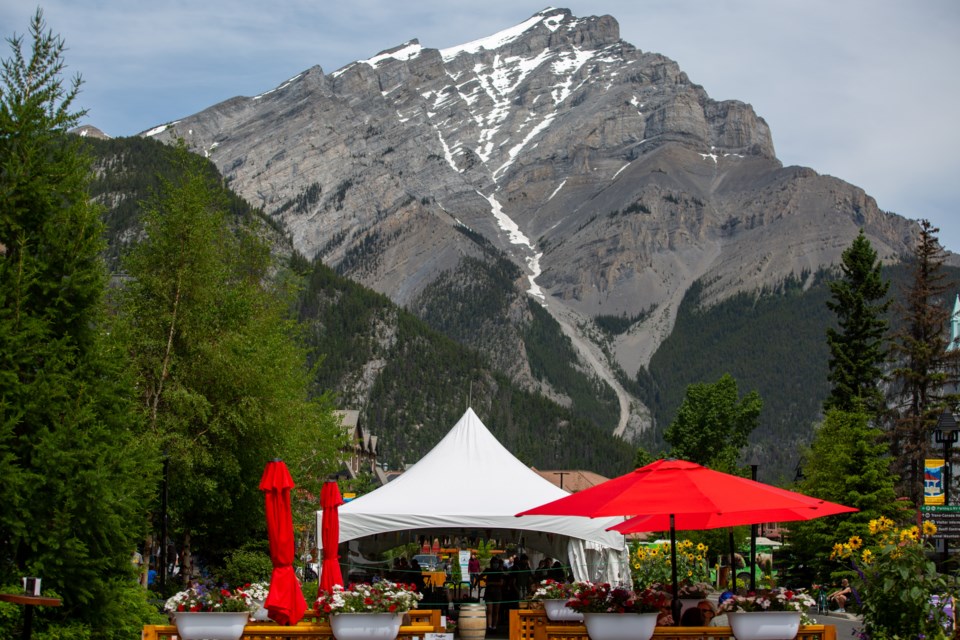BANFF – Banff is bracing for an increase in visitation next summer, prompting the municipality to investigate ways to deal with potential traffic congestion in light of the downtown pedestrian zone going ahead again next summer.
The municipality will consider visitor paid parking as one way to motivate visitors to park at free intercept lots at the Fenlands rec centre and Banff train station, along with a shuttle service to bring visitors into downtown.
Mayor Karen Sorensen said these recommendations will be discussed during council’s review of municipal services and associated budgets, which gets underway in January.
“I appreciate that the disincentives, particularly around visitor paid parking, are a bigger conversation for service review,” she said during the Dec. 7 council meeting.
“We also have to get those shuttle services back at the intercept parking lots. I think that’s a huge piece of this as well.”
While it is unclear what the social distancing requirements will be next summer, the Town of Banff believes the downtown pedestrian zone will be an attraction for visitors regardless of COVID-19.
Officials say there was very little traffic congestion in Banff last summer, noting that was due to the lower number of visitors in town, but also when people chose to visit.
In addition, they say various closures of tourist attractions on the south side of the Bow River such as the Upper Hot Springs, Banff Gondola and Banff Cave and Basin led to diminished traffic across the bridge – a traffic pinch point in a normal year.
“In 2020, not only were less people coming, but they were behaving in different ways when they got here,” said Darren Enns, the Town of Banff’s director of planning and development.
But for next summer, Banff is expecting to see visitation on par or even higher than 2020 levels.
With that comes concerns of increased traffic and congestion, and with the pedestrian zone shutting off the 100 and 200 block off Banff Avenue, more vehicles heading through residential neighbourhoods such as Beaver Street or along Lynx Street.
“Our belief is various travel restrictions will still be in place and we will have a lot of domestic and regional tourism, and that those people will be looking to get out for healthy experiences in the mountains,” Enns said.
“We’re trying to think ahead for 2021 and plan for a bit of a bump in vehicular traffic.”
To that end, administration recommends that along with any pedestrian zone in 2021, there must be other measures taken to minimize the risk of vehicle congestion.
Administration believes that downtown parking disincentives would motivate drivers to park at the intercept lots at the Fenlands and train station – where there are a total of 750 stalls. Last summer, it was less than half full most of the time.
Options under consideration include visitor pay parking in the downtown core.
Other recommendations include converting longer-term parking stalls to shorter term. This aims to get those who want to stay in town longer to park at the intercept lots where there is long-term parking.
“While part of a much broader discussion, administration is of the opinion that visitor paid parking downtown, coupled with free intercept parking, would be a significant motivator to make use of intercept parking,” Enns said.
In addition, there are a list of recommendations to encourage visitors to park at the intercept lots, such as parking and way-finding ambassadors and the return of a shuttle service between downtown and the train station.
“While in the past this has been focused on bus infrastructure there may be alternatives such as micro-shuttles using small electric vehicles that may be as effective,” Enns said.
Councillor Corrie DiManno said she was glad to see administration thinking ahead to next year, noting she believes the downtown pedestrian zone will be even more of an attraction next summer and more visitors could lead to “car-mageddon”.
“Looking at these disincentives, I hope that council really takes a good look at these during service,” she said.
“If not, we might be in a place where our downtown core will see car catastrophe. It was very good we didn’t see that this summer, but we might see more visitation coming into 2021.”
In anticipation of a busier year, administration has also suggested changing the configuration of the pedestrian zone to create another 1,400-square-metres for people to walk.
Under the current plan, both interior lanes closest to the median on the 100 and 200 block of Banff Avenue would be clear of any commercial sidewalk seating or retail displays.
On Caribou Street, administration recommends a flipped configuration from 2020, which would place restaurants’ seating adjacent to buildings and along sidewalks, leaving the walking lane in the middle.
“Given the conflicts observed between passing pedestrians and restaurant queues on this street, it is believed that this will create a more effective pedestrian environment in the centre of the street and still allow Caribou restaurants a similar amount of space for outdoor seating,” Enns said.
There is, however, talk of trying to find a way to include Roam public transit through the pedestrian zone.
Read more from RMOToday.com



